BUSI2211: Consumer Psychology and Darwinian Meta-Drives Analysis
VerifiedAdded on 2022/08/21
|13
|2370
|13
Essay
AI Summary
This essay critically evaluates the application of Gad Saad's four Darwinian meta-drives (survival, reproduction, kin selection, and reciprocal altruism) to consumer behavior, specifically focusing on the evolution of consumerism within the fast-moving consumer goods (FMCG) sector, using toothpaste as a case study. The paper explores how factors like globalization, technological advancements, and competition have reshaped consumer demands and purchasing patterns. It delves into the psychological underpinnings of consumer decisions, linking them to the meta-drives and examining how these drives influence product choices, information seeking, evaluation, and brand loyalty. The essay traces the historical evolution of toothpaste, from powder to modern formulations, illustrating how product innovation and marketing strategies align with the changing needs and preferences of consumers. It also explores how the digital age and media influence consumer behavior, emphasizing the importance of understanding these evolutionary principles for effective marketing and brand management within the FMCG industry. The analysis incorporates cultural, social, personal, psychological, and financial factors affecting consumer decisions.

Running head: EVOLUTION OF CONSUMERISM
EVOLUTION OF CONSUMERISM
Name of the student:
Name of the University:
Author Note:
EVOLUTION OF CONSUMERISM
Name of the student:
Name of the University:
Author Note:
Paraphrase This Document
Need a fresh take? Get an instant paraphrase of this document with our AI Paraphraser
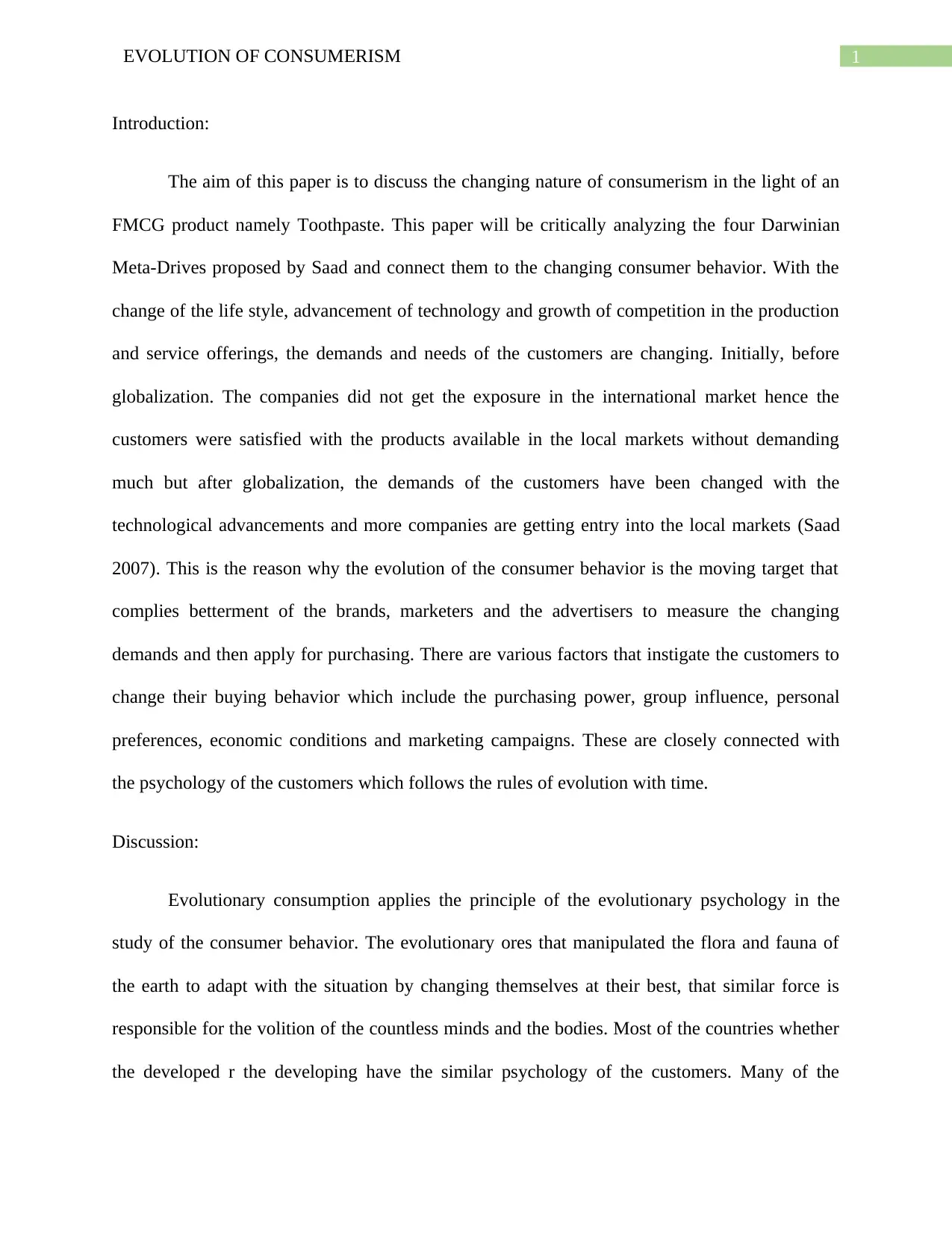
1EVOLUTION OF CONSUMERISM
Introduction:
The aim of this paper is to discuss the changing nature of consumerism in the light of an
FMCG product namely Toothpaste. This paper will be critically analyzing the four Darwinian
Meta-Drives proposed by Saad and connect them to the changing consumer behavior. With the
change of the life style, advancement of technology and growth of competition in the production
and service offerings, the demands and needs of the customers are changing. Initially, before
globalization. The companies did not get the exposure in the international market hence the
customers were satisfied with the products available in the local markets without demanding
much but after globalization, the demands of the customers have been changed with the
technological advancements and more companies are getting entry into the local markets (Saad
2007). This is the reason why the evolution of the consumer behavior is the moving target that
complies betterment of the brands, marketers and the advertisers to measure the changing
demands and then apply for purchasing. There are various factors that instigate the customers to
change their buying behavior which include the purchasing power, group influence, personal
preferences, economic conditions and marketing campaigns. These are closely connected with
the psychology of the customers which follows the rules of evolution with time.
Discussion:
Evolutionary consumption applies the principle of the evolutionary psychology in the
study of the consumer behavior. The evolutionary ores that manipulated the flora and fauna of
the earth to adapt with the situation by changing themselves at their best, that similar force is
responsible for the volition of the countless minds and the bodies. Most of the countries whether
the developed r the developing have the similar psychology of the customers. Many of the
Introduction:
The aim of this paper is to discuss the changing nature of consumerism in the light of an
FMCG product namely Toothpaste. This paper will be critically analyzing the four Darwinian
Meta-Drives proposed by Saad and connect them to the changing consumer behavior. With the
change of the life style, advancement of technology and growth of competition in the production
and service offerings, the demands and needs of the customers are changing. Initially, before
globalization. The companies did not get the exposure in the international market hence the
customers were satisfied with the products available in the local markets without demanding
much but after globalization, the demands of the customers have been changed with the
technological advancements and more companies are getting entry into the local markets (Saad
2007). This is the reason why the evolution of the consumer behavior is the moving target that
complies betterment of the brands, marketers and the advertisers to measure the changing
demands and then apply for purchasing. There are various factors that instigate the customers to
change their buying behavior which include the purchasing power, group influence, personal
preferences, economic conditions and marketing campaigns. These are closely connected with
the psychology of the customers which follows the rules of evolution with time.
Discussion:
Evolutionary consumption applies the principle of the evolutionary psychology in the
study of the consumer behavior. The evolutionary ores that manipulated the flora and fauna of
the earth to adapt with the situation by changing themselves at their best, that similar force is
responsible for the volition of the countless minds and the bodies. Most of the countries whether
the developed r the developing have the similar psychology of the customers. Many of the
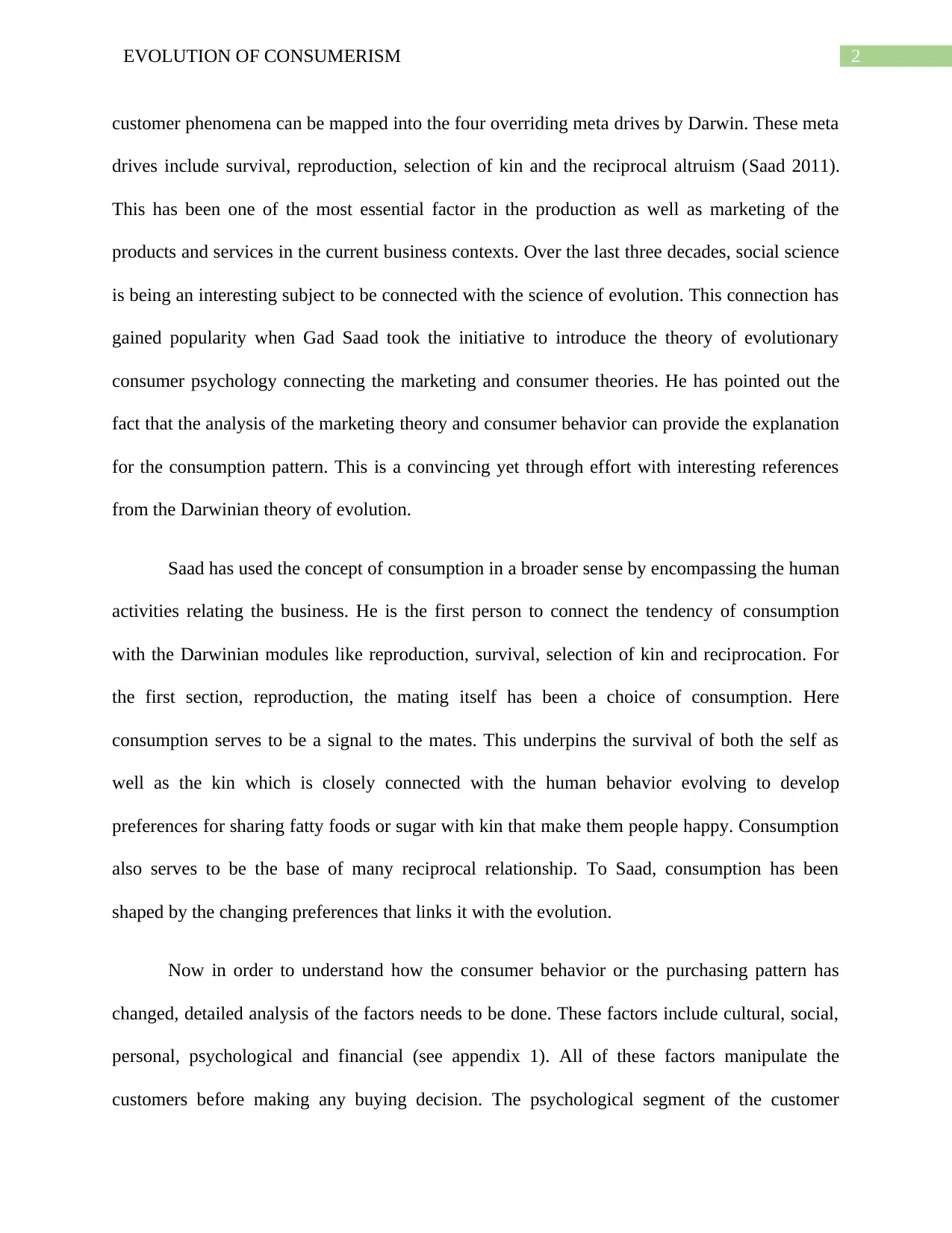
2EVOLUTION OF CONSUMERISM
customer phenomena can be mapped into the four overriding meta drives by Darwin. These meta
drives include survival, reproduction, selection of kin and the reciprocal altruism (Saad 2011).
This has been one of the most essential factor in the production as well as marketing of the
products and services in the current business contexts. Over the last three decades, social science
is being an interesting subject to be connected with the science of evolution. This connection has
gained popularity when Gad Saad took the initiative to introduce the theory of evolutionary
consumer psychology connecting the marketing and consumer theories. He has pointed out the
fact that the analysis of the marketing theory and consumer behavior can provide the explanation
for the consumption pattern. This is a convincing yet through effort with interesting references
from the Darwinian theory of evolution.
Saad has used the concept of consumption in a broader sense by encompassing the human
activities relating the business. He is the first person to connect the tendency of consumption
with the Darwinian modules like reproduction, survival, selection of kin and reciprocation. For
the first section, reproduction, the mating itself has been a choice of consumption. Here
consumption serves to be a signal to the mates. This underpins the survival of both the self as
well as the kin which is closely connected with the human behavior evolving to develop
preferences for sharing fatty foods or sugar with kin that make them people happy. Consumption
also serves to be the base of many reciprocal relationship. To Saad, consumption has been
shaped by the changing preferences that links it with the evolution.
Now in order to understand how the consumer behavior or the purchasing pattern has
changed, detailed analysis of the factors needs to be done. These factors include cultural, social,
personal, psychological and financial (see appendix 1). All of these factors manipulate the
customers before making any buying decision. The psychological segment of the customer
customer phenomena can be mapped into the four overriding meta drives by Darwin. These meta
drives include survival, reproduction, selection of kin and the reciprocal altruism (Saad 2011).
This has been one of the most essential factor in the production as well as marketing of the
products and services in the current business contexts. Over the last three decades, social science
is being an interesting subject to be connected with the science of evolution. This connection has
gained popularity when Gad Saad took the initiative to introduce the theory of evolutionary
consumer psychology connecting the marketing and consumer theories. He has pointed out the
fact that the analysis of the marketing theory and consumer behavior can provide the explanation
for the consumption pattern. This is a convincing yet through effort with interesting references
from the Darwinian theory of evolution.
Saad has used the concept of consumption in a broader sense by encompassing the human
activities relating the business. He is the first person to connect the tendency of consumption
with the Darwinian modules like reproduction, survival, selection of kin and reciprocation. For
the first section, reproduction, the mating itself has been a choice of consumption. Here
consumption serves to be a signal to the mates. This underpins the survival of both the self as
well as the kin which is closely connected with the human behavior evolving to develop
preferences for sharing fatty foods or sugar with kin that make them people happy. Consumption
also serves to be the base of many reciprocal relationship. To Saad, consumption has been
shaped by the changing preferences that links it with the evolution.
Now in order to understand how the consumer behavior or the purchasing pattern has
changed, detailed analysis of the factors needs to be done. These factors include cultural, social,
personal, psychological and financial (see appendix 1). All of these factors manipulate the
customers before making any buying decision. The psychological segment of the customer
⊘ This is a preview!⊘
Do you want full access?
Subscribe today to unlock all pages.

Trusted by 1+ million students worldwide
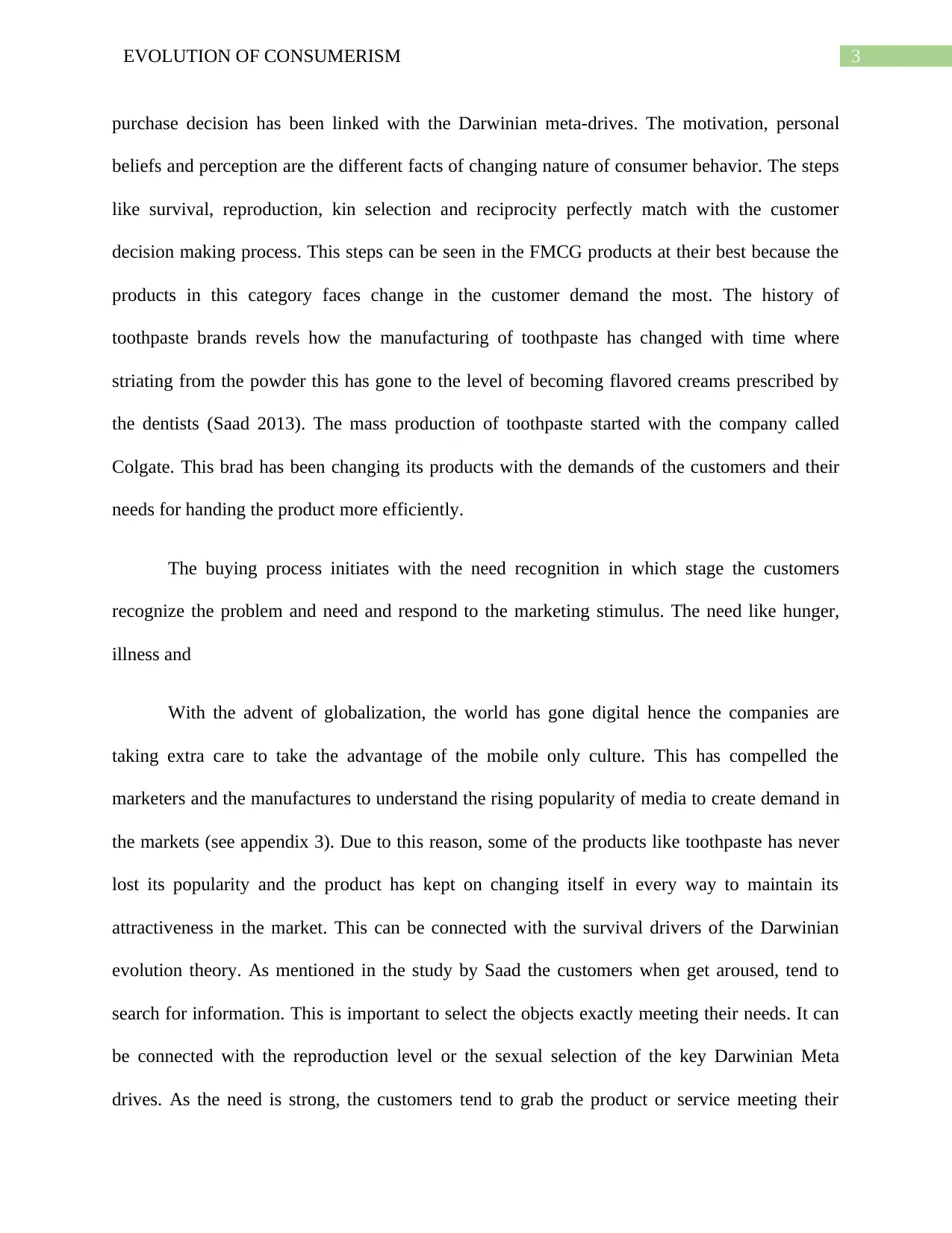
3EVOLUTION OF CONSUMERISM
purchase decision has been linked with the Darwinian meta-drives. The motivation, personal
beliefs and perception are the different facts of changing nature of consumer behavior. The steps
like survival, reproduction, kin selection and reciprocity perfectly match with the customer
decision making process. This steps can be seen in the FMCG products at their best because the
products in this category faces change in the customer demand the most. The history of
toothpaste brands revels how the manufacturing of toothpaste has changed with time where
striating from the powder this has gone to the level of becoming flavored creams prescribed by
the dentists (Saad 2013). The mass production of toothpaste started with the company called
Colgate. This brad has been changing its products with the demands of the customers and their
needs for handing the product more efficiently.
The buying process initiates with the need recognition in which stage the customers
recognize the problem and need and respond to the marketing stimulus. The need like hunger,
illness and
With the advent of globalization, the world has gone digital hence the companies are
taking extra care to take the advantage of the mobile only culture. This has compelled the
marketers and the manufactures to understand the rising popularity of media to create demand in
the markets (see appendix 3). Due to this reason, some of the products like toothpaste has never
lost its popularity and the product has kept on changing itself in every way to maintain its
attractiveness in the market. This can be connected with the survival drivers of the Darwinian
evolution theory. As mentioned in the study by Saad the customers when get aroused, tend to
search for information. This is important to select the objects exactly meeting their needs. It can
be connected with the reproduction level or the sexual selection of the key Darwinian Meta
drives. As the need is strong, the customers tend to grab the product or service meeting their
purchase decision has been linked with the Darwinian meta-drives. The motivation, personal
beliefs and perception are the different facts of changing nature of consumer behavior. The steps
like survival, reproduction, kin selection and reciprocity perfectly match with the customer
decision making process. This steps can be seen in the FMCG products at their best because the
products in this category faces change in the customer demand the most. The history of
toothpaste brands revels how the manufacturing of toothpaste has changed with time where
striating from the powder this has gone to the level of becoming flavored creams prescribed by
the dentists (Saad 2013). The mass production of toothpaste started with the company called
Colgate. This brad has been changing its products with the demands of the customers and their
needs for handing the product more efficiently.
The buying process initiates with the need recognition in which stage the customers
recognize the problem and need and respond to the marketing stimulus. The need like hunger,
illness and
With the advent of globalization, the world has gone digital hence the companies are
taking extra care to take the advantage of the mobile only culture. This has compelled the
marketers and the manufactures to understand the rising popularity of media to create demand in
the markets (see appendix 3). Due to this reason, some of the products like toothpaste has never
lost its popularity and the product has kept on changing itself in every way to maintain its
attractiveness in the market. This can be connected with the survival drivers of the Darwinian
evolution theory. As mentioned in the study by Saad the customers when get aroused, tend to
search for information. This is important to select the objects exactly meeting their needs. It can
be connected with the reproduction level or the sexual selection of the key Darwinian Meta
drives. As the need is strong, the customers tend to grab the product or service meeting their
Paraphrase This Document
Need a fresh take? Get an instant paraphrase of this document with our AI Paraphraser
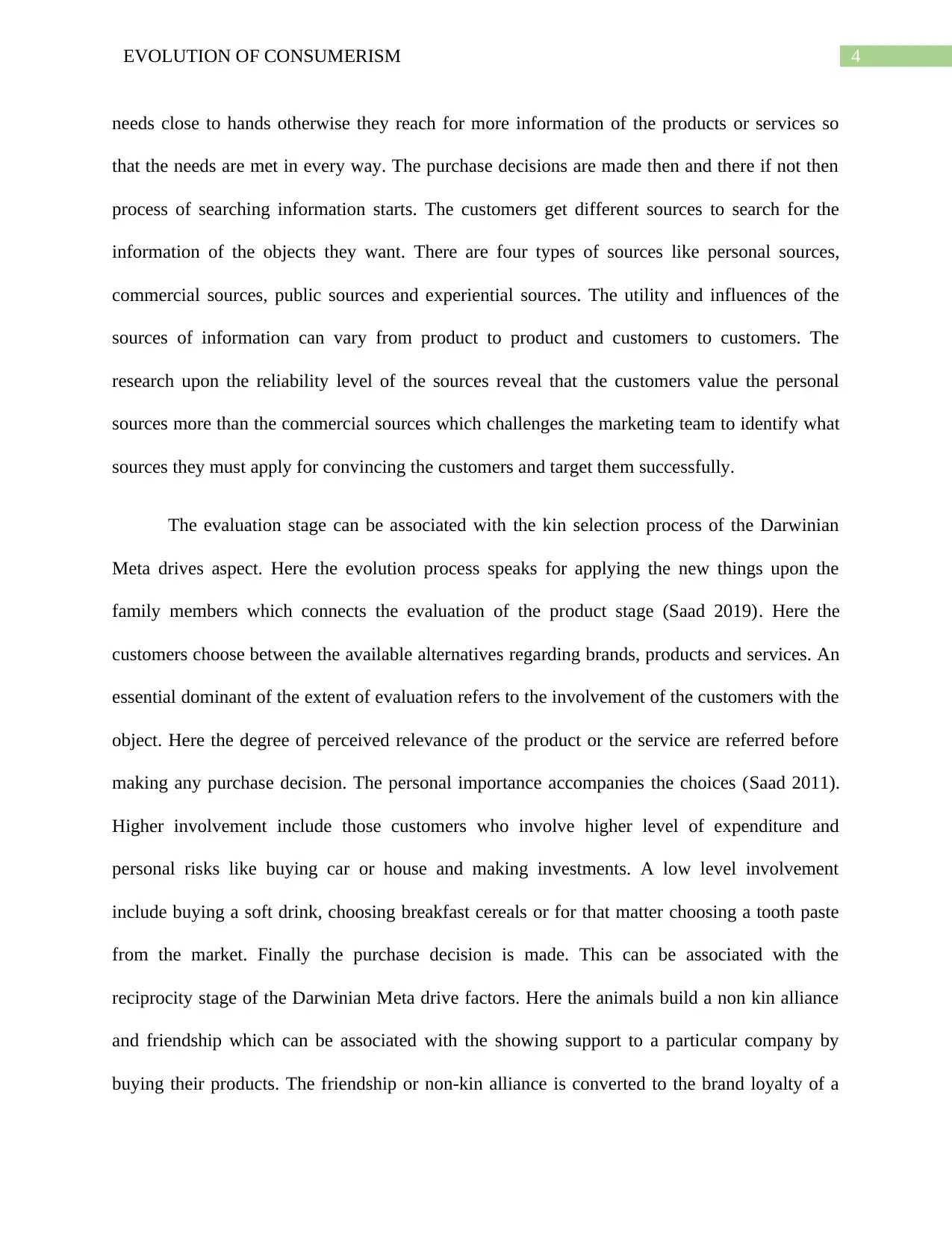
4EVOLUTION OF CONSUMERISM
needs close to hands otherwise they reach for more information of the products or services so
that the needs are met in every way. The purchase decisions are made then and there if not then
process of searching information starts. The customers get different sources to search for the
information of the objects they want. There are four types of sources like personal sources,
commercial sources, public sources and experiential sources. The utility and influences of the
sources of information can vary from product to product and customers to customers. The
research upon the reliability level of the sources reveal that the customers value the personal
sources more than the commercial sources which challenges the marketing team to identify what
sources they must apply for convincing the customers and target them successfully.
The evaluation stage can be associated with the kin selection process of the Darwinian
Meta drives aspect. Here the evolution process speaks for applying the new things upon the
family members which connects the evaluation of the product stage (Saad 2019). Here the
customers choose between the available alternatives regarding brands, products and services. An
essential dominant of the extent of evaluation refers to the involvement of the customers with the
object. Here the degree of perceived relevance of the product or the service are referred before
making any purchase decision. The personal importance accompanies the choices (Saad 2011).
Higher involvement include those customers who involve higher level of expenditure and
personal risks like buying car or house and making investments. A low level involvement
include buying a soft drink, choosing breakfast cereals or for that matter choosing a tooth paste
from the market. Finally the purchase decision is made. This can be associated with the
reciprocity stage of the Darwinian Meta drive factors. Here the animals build a non kin alliance
and friendship which can be associated with the showing support to a particular company by
buying their products. The friendship or non-kin alliance is converted to the brand loyalty of a
needs close to hands otherwise they reach for more information of the products or services so
that the needs are met in every way. The purchase decisions are made then and there if not then
process of searching information starts. The customers get different sources to search for the
information of the objects they want. There are four types of sources like personal sources,
commercial sources, public sources and experiential sources. The utility and influences of the
sources of information can vary from product to product and customers to customers. The
research upon the reliability level of the sources reveal that the customers value the personal
sources more than the commercial sources which challenges the marketing team to identify what
sources they must apply for convincing the customers and target them successfully.
The evaluation stage can be associated with the kin selection process of the Darwinian
Meta drives aspect. Here the evolution process speaks for applying the new things upon the
family members which connects the evaluation of the product stage (Saad 2019). Here the
customers choose between the available alternatives regarding brands, products and services. An
essential dominant of the extent of evaluation refers to the involvement of the customers with the
object. Here the degree of perceived relevance of the product or the service are referred before
making any purchase decision. The personal importance accompanies the choices (Saad 2011).
Higher involvement include those customers who involve higher level of expenditure and
personal risks like buying car or house and making investments. A low level involvement
include buying a soft drink, choosing breakfast cereals or for that matter choosing a tooth paste
from the market. Finally the purchase decision is made. This can be associated with the
reciprocity stage of the Darwinian Meta drive factors. Here the animals build a non kin alliance
and friendship which can be associated with the showing support to a particular company by
buying their products. The friendship or non-kin alliance is converted to the brand loyalty of a
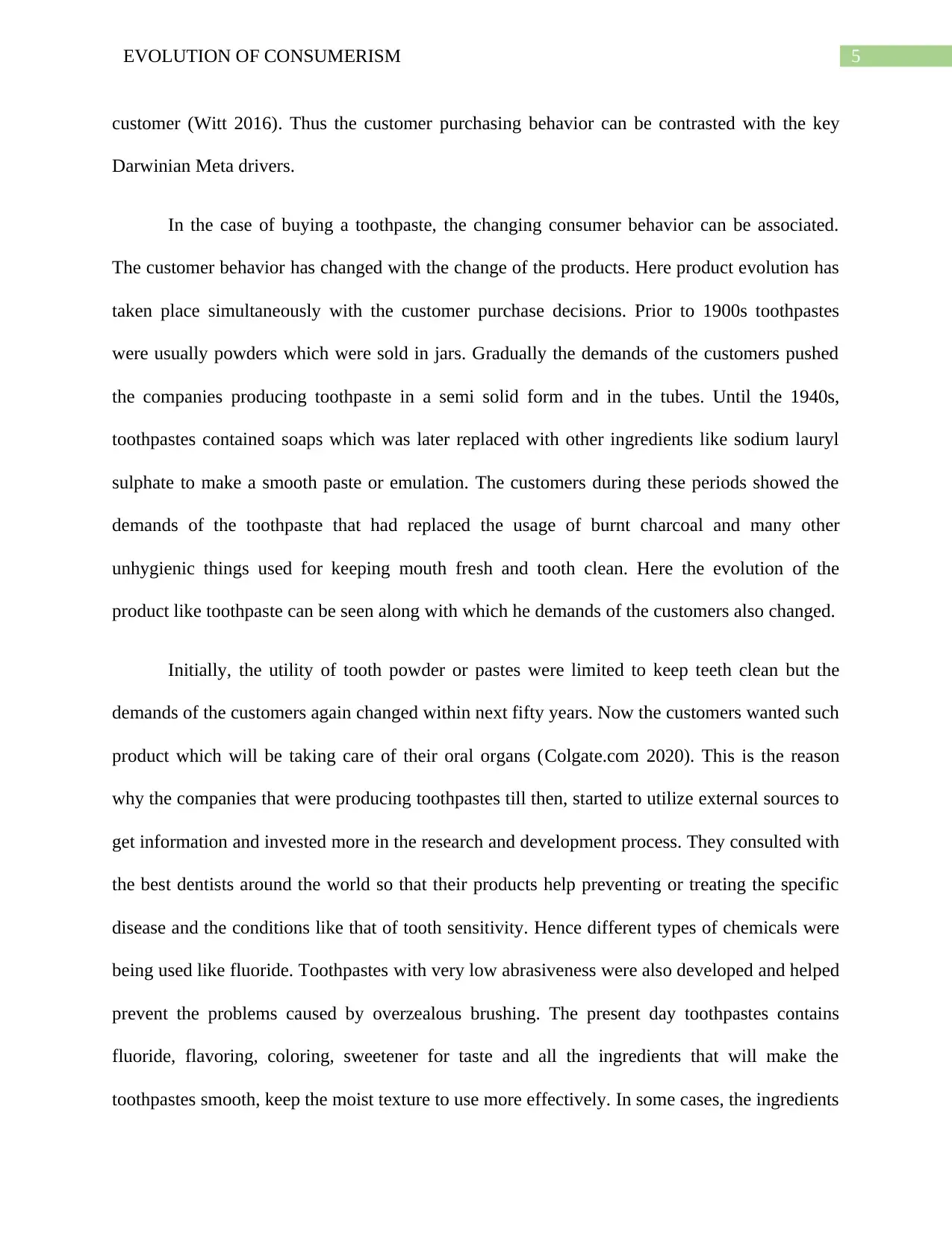
5EVOLUTION OF CONSUMERISM
customer (Witt 2016). Thus the customer purchasing behavior can be contrasted with the key
Darwinian Meta drivers.
In the case of buying a toothpaste, the changing consumer behavior can be associated.
The customer behavior has changed with the change of the products. Here product evolution has
taken place simultaneously with the customer purchase decisions. Prior to 1900s toothpastes
were usually powders which were sold in jars. Gradually the demands of the customers pushed
the companies producing toothpaste in a semi solid form and in the tubes. Until the 1940s,
toothpastes contained soaps which was later replaced with other ingredients like sodium lauryl
sulphate to make a smooth paste or emulation. The customers during these periods showed the
demands of the toothpaste that had replaced the usage of burnt charcoal and many other
unhygienic things used for keeping mouth fresh and tooth clean. Here the evolution of the
product like toothpaste can be seen along with which he demands of the customers also changed.
Initially, the utility of tooth powder or pastes were limited to keep teeth clean but the
demands of the customers again changed within next fifty years. Now the customers wanted such
product which will be taking care of their oral organs (Colgate.com 2020). This is the reason
why the companies that were producing toothpastes till then, started to utilize external sources to
get information and invested more in the research and development process. They consulted with
the best dentists around the world so that their products help preventing or treating the specific
disease and the conditions like that of tooth sensitivity. Hence different types of chemicals were
being used like fluoride. Toothpastes with very low abrasiveness were also developed and helped
prevent the problems caused by overzealous brushing. The present day toothpastes contains
fluoride, flavoring, coloring, sweetener for taste and all the ingredients that will make the
toothpastes smooth, keep the moist texture to use more effectively. In some cases, the ingredients
customer (Witt 2016). Thus the customer purchasing behavior can be contrasted with the key
Darwinian Meta drivers.
In the case of buying a toothpaste, the changing consumer behavior can be associated.
The customer behavior has changed with the change of the products. Here product evolution has
taken place simultaneously with the customer purchase decisions. Prior to 1900s toothpastes
were usually powders which were sold in jars. Gradually the demands of the customers pushed
the companies producing toothpaste in a semi solid form and in the tubes. Until the 1940s,
toothpastes contained soaps which was later replaced with other ingredients like sodium lauryl
sulphate to make a smooth paste or emulation. The customers during these periods showed the
demands of the toothpaste that had replaced the usage of burnt charcoal and many other
unhygienic things used for keeping mouth fresh and tooth clean. Here the evolution of the
product like toothpaste can be seen along with which he demands of the customers also changed.
Initially, the utility of tooth powder or pastes were limited to keep teeth clean but the
demands of the customers again changed within next fifty years. Now the customers wanted such
product which will be taking care of their oral organs (Colgate.com 2020). This is the reason
why the companies that were producing toothpastes till then, started to utilize external sources to
get information and invested more in the research and development process. They consulted with
the best dentists around the world so that their products help preventing or treating the specific
disease and the conditions like that of tooth sensitivity. Hence different types of chemicals were
being used like fluoride. Toothpastes with very low abrasiveness were also developed and helped
prevent the problems caused by overzealous brushing. The present day toothpastes contains
fluoride, flavoring, coloring, sweetener for taste and all the ingredients that will make the
toothpastes smooth, keep the moist texture to use more effectively. In some cases, the ingredients
⊘ This is a preview!⊘
Do you want full access?
Subscribe today to unlock all pages.

Trusted by 1+ million students worldwide
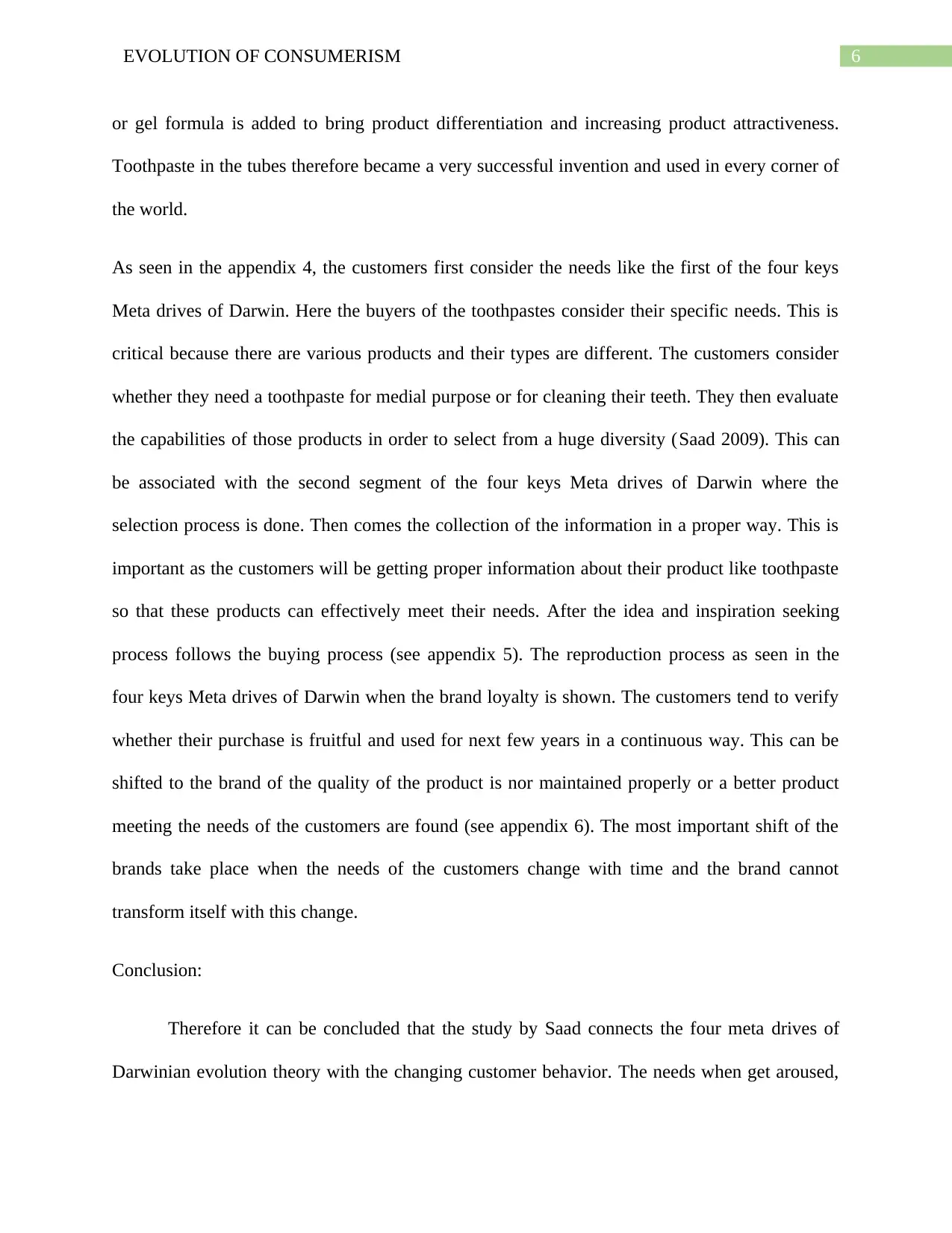
6EVOLUTION OF CONSUMERISM
or gel formula is added to bring product differentiation and increasing product attractiveness.
Toothpaste in the tubes therefore became a very successful invention and used in every corner of
the world.
As seen in the appendix 4, the customers first consider the needs like the first of the four keys
Meta drives of Darwin. Here the buyers of the toothpastes consider their specific needs. This is
critical because there are various products and their types are different. The customers consider
whether they need a toothpaste for medial purpose or for cleaning their teeth. They then evaluate
the capabilities of those products in order to select from a huge diversity (Saad 2009). This can
be associated with the second segment of the four keys Meta drives of Darwin where the
selection process is done. Then comes the collection of the information in a proper way. This is
important as the customers will be getting proper information about their product like toothpaste
so that these products can effectively meet their needs. After the idea and inspiration seeking
process follows the buying process (see appendix 5). The reproduction process as seen in the
four keys Meta drives of Darwin when the brand loyalty is shown. The customers tend to verify
whether their purchase is fruitful and used for next few years in a continuous way. This can be
shifted to the brand of the quality of the product is nor maintained properly or a better product
meeting the needs of the customers are found (see appendix 6). The most important shift of the
brands take place when the needs of the customers change with time and the brand cannot
transform itself with this change.
Conclusion:
Therefore it can be concluded that the study by Saad connects the four meta drives of
Darwinian evolution theory with the changing customer behavior. The needs when get aroused,
or gel formula is added to bring product differentiation and increasing product attractiveness.
Toothpaste in the tubes therefore became a very successful invention and used in every corner of
the world.
As seen in the appendix 4, the customers first consider the needs like the first of the four keys
Meta drives of Darwin. Here the buyers of the toothpastes consider their specific needs. This is
critical because there are various products and their types are different. The customers consider
whether they need a toothpaste for medial purpose or for cleaning their teeth. They then evaluate
the capabilities of those products in order to select from a huge diversity (Saad 2009). This can
be associated with the second segment of the four keys Meta drives of Darwin where the
selection process is done. Then comes the collection of the information in a proper way. This is
important as the customers will be getting proper information about their product like toothpaste
so that these products can effectively meet their needs. After the idea and inspiration seeking
process follows the buying process (see appendix 5). The reproduction process as seen in the
four keys Meta drives of Darwin when the brand loyalty is shown. The customers tend to verify
whether their purchase is fruitful and used for next few years in a continuous way. This can be
shifted to the brand of the quality of the product is nor maintained properly or a better product
meeting the needs of the customers are found (see appendix 6). The most important shift of the
brands take place when the needs of the customers change with time and the brand cannot
transform itself with this change.
Conclusion:
Therefore it can be concluded that the study by Saad connects the four meta drives of
Darwinian evolution theory with the changing customer behavior. The needs when get aroused,
Paraphrase This Document
Need a fresh take? Get an instant paraphrase of this document with our AI Paraphraser
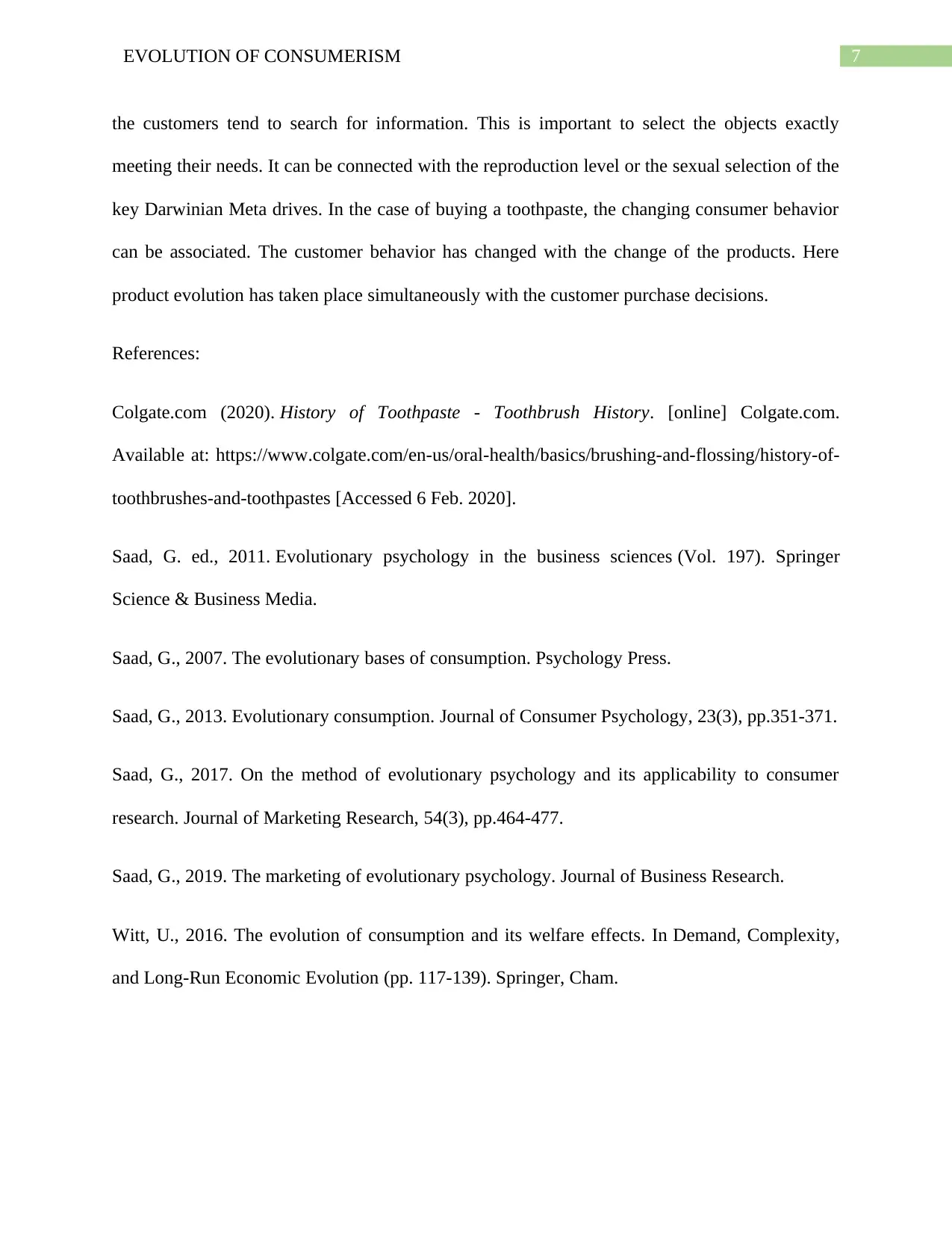
7EVOLUTION OF CONSUMERISM
the customers tend to search for information. This is important to select the objects exactly
meeting their needs. It can be connected with the reproduction level or the sexual selection of the
key Darwinian Meta drives. In the case of buying a toothpaste, the changing consumer behavior
can be associated. The customer behavior has changed with the change of the products. Here
product evolution has taken place simultaneously with the customer purchase decisions.
References:
Colgate.com (2020). History of Toothpaste - Toothbrush History. [online] Colgate.com.
Available at: https://www.colgate.com/en-us/oral-health/basics/brushing-and-flossing/history-of-
toothbrushes-and-toothpastes [Accessed 6 Feb. 2020].
Saad, G. ed., 2011. Evolutionary psychology in the business sciences (Vol. 197). Springer
Science & Business Media.
Saad, G., 2007. The evolutionary bases of consumption. Psychology Press.
Saad, G., 2013. Evolutionary consumption. Journal of Consumer Psychology, 23(3), pp.351-371.
Saad, G., 2017. On the method of evolutionary psychology and its applicability to consumer
research. Journal of Marketing Research, 54(3), pp.464-477.
Saad, G., 2019. The marketing of evolutionary psychology. Journal of Business Research.
Witt, U., 2016. The evolution of consumption and its welfare effects. In Demand, Complexity,
and Long-Run Economic Evolution (pp. 117-139). Springer, Cham.
the customers tend to search for information. This is important to select the objects exactly
meeting their needs. It can be connected with the reproduction level or the sexual selection of the
key Darwinian Meta drives. In the case of buying a toothpaste, the changing consumer behavior
can be associated. The customer behavior has changed with the change of the products. Here
product evolution has taken place simultaneously with the customer purchase decisions.
References:
Colgate.com (2020). History of Toothpaste - Toothbrush History. [online] Colgate.com.
Available at: https://www.colgate.com/en-us/oral-health/basics/brushing-and-flossing/history-of-
toothbrushes-and-toothpastes [Accessed 6 Feb. 2020].
Saad, G. ed., 2011. Evolutionary psychology in the business sciences (Vol. 197). Springer
Science & Business Media.
Saad, G., 2007. The evolutionary bases of consumption. Psychology Press.
Saad, G., 2013. Evolutionary consumption. Journal of Consumer Psychology, 23(3), pp.351-371.
Saad, G., 2017. On the method of evolutionary psychology and its applicability to consumer
research. Journal of Marketing Research, 54(3), pp.464-477.
Saad, G., 2019. The marketing of evolutionary psychology. Journal of Business Research.
Witt, U., 2016. The evolution of consumption and its welfare effects. In Demand, Complexity,
and Long-Run Economic Evolution (pp. 117-139). Springer, Cham.
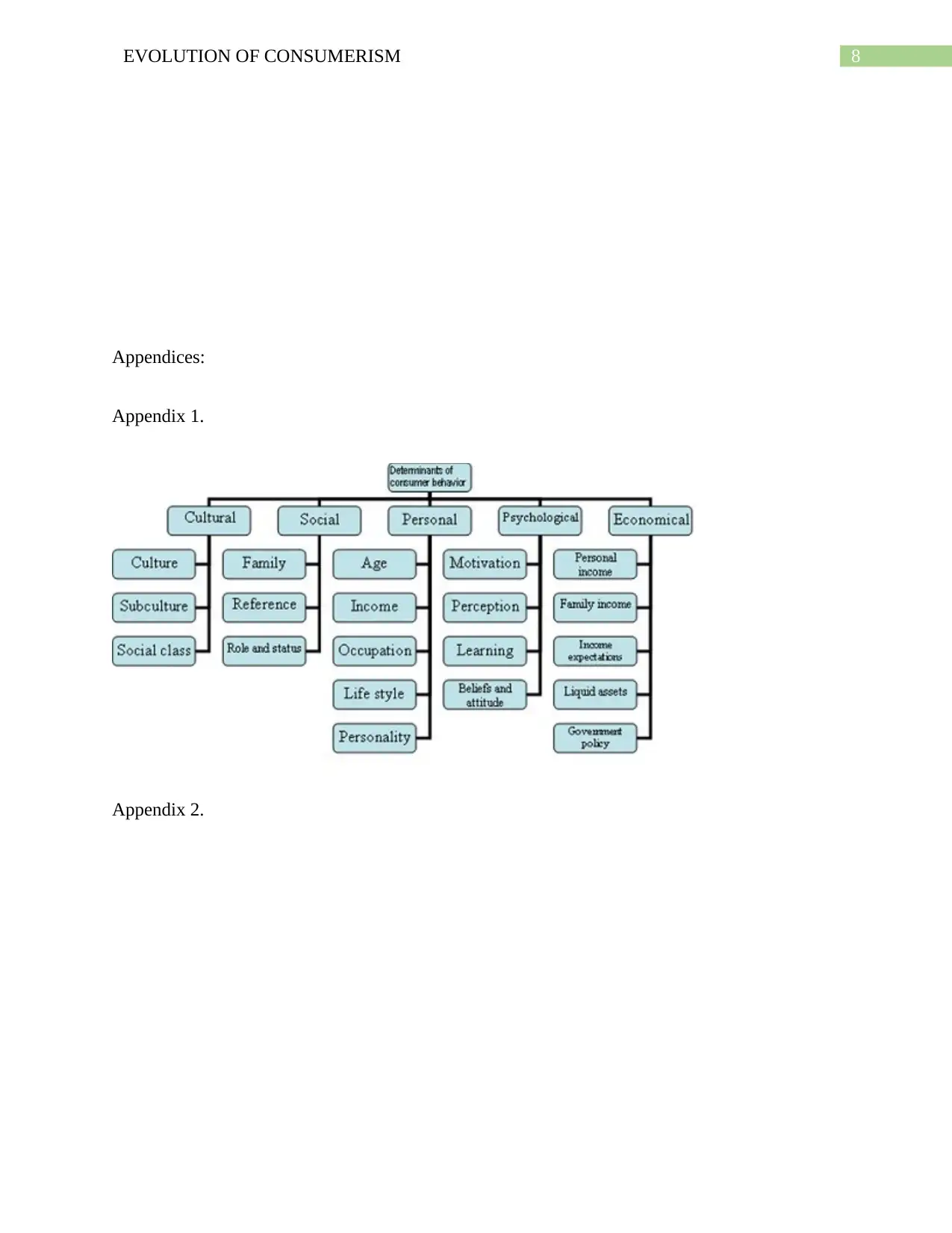
8EVOLUTION OF CONSUMERISM
Appendices:
Appendix 1.
Appendix 2.
Appendices:
Appendix 1.
Appendix 2.
⊘ This is a preview!⊘
Do you want full access?
Subscribe today to unlock all pages.

Trusted by 1+ million students worldwide
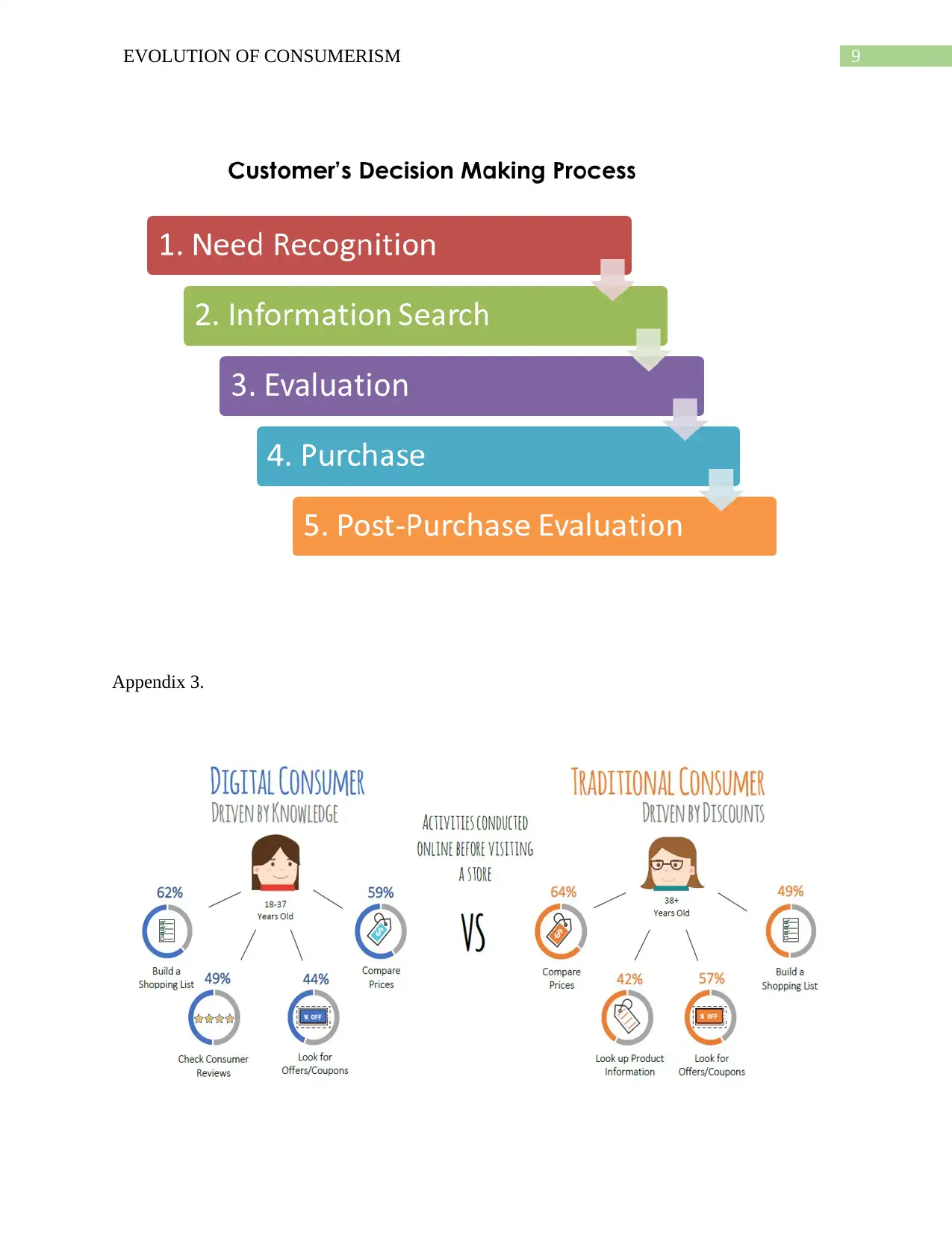
9EVOLUTION OF CONSUMERISM
Appendix 3.
Appendix 3.
Paraphrase This Document
Need a fresh take? Get an instant paraphrase of this document with our AI Paraphraser
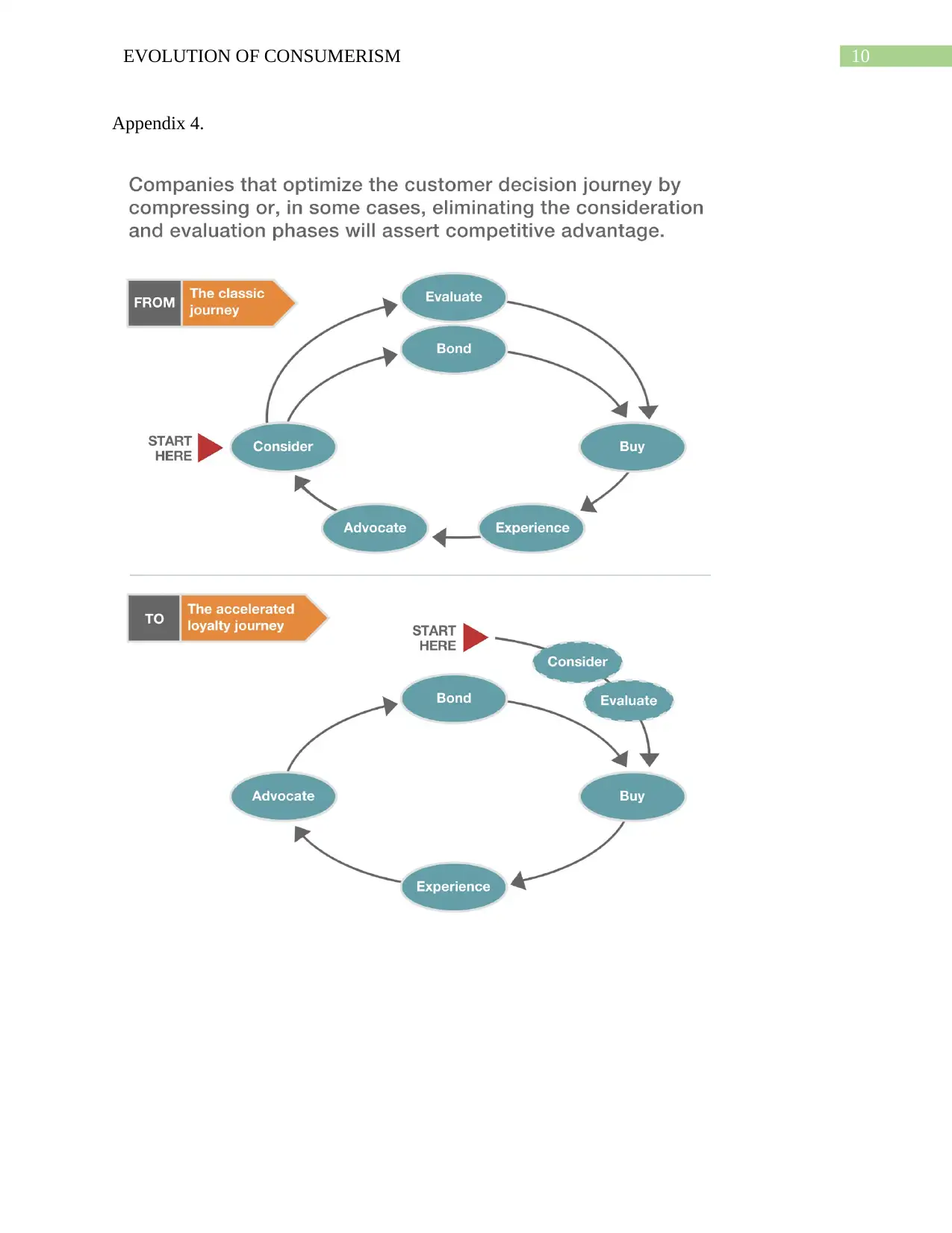
10EVOLUTION OF CONSUMERISM
Appendix 4.
Appendix 4.
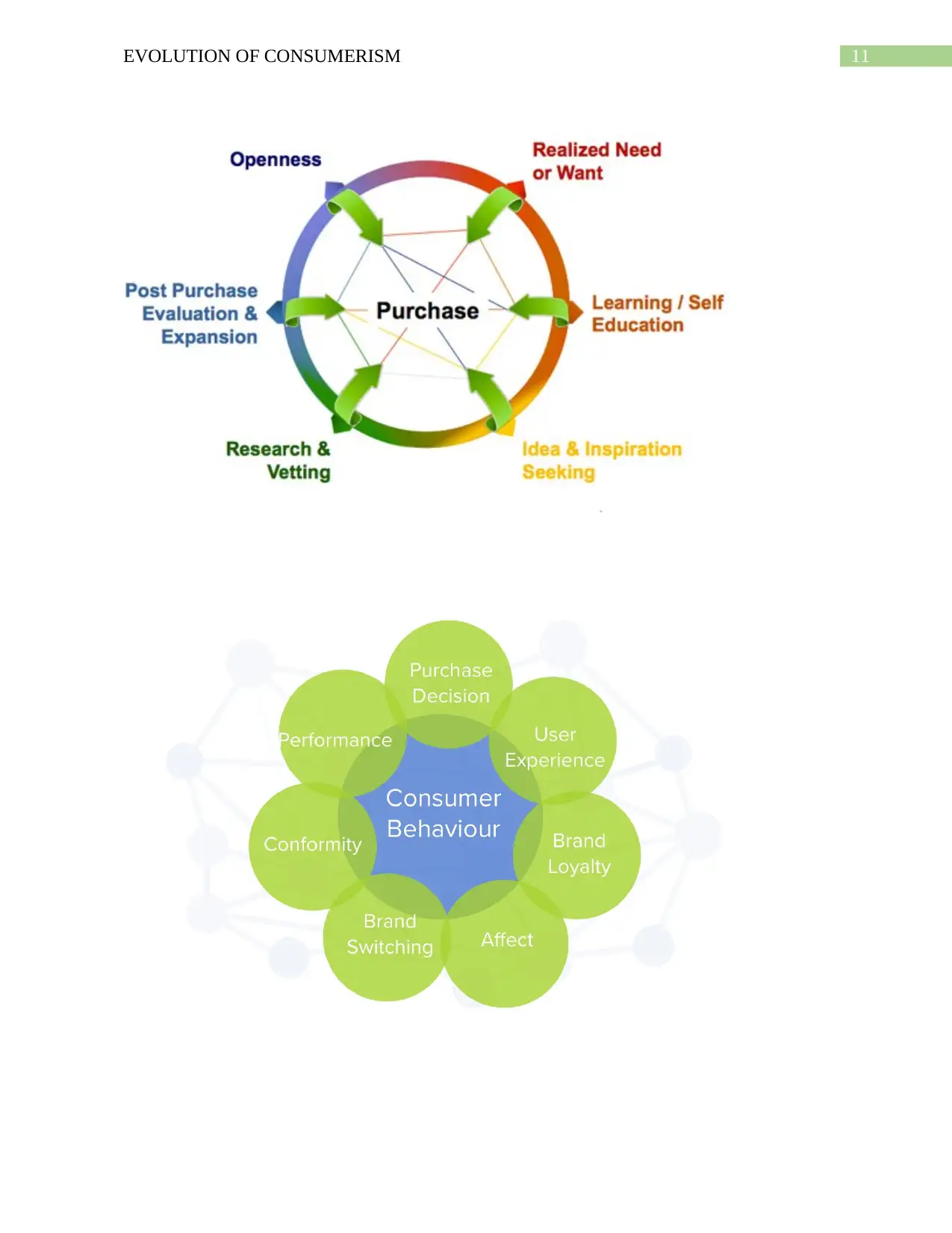
11EVOLUTION OF CONSUMERISM
⊘ This is a preview!⊘
Do you want full access?
Subscribe today to unlock all pages.

Trusted by 1+ million students worldwide
1 out of 13
Your All-in-One AI-Powered Toolkit for Academic Success.
+13062052269
info@desklib.com
Available 24*7 on WhatsApp / Email
![[object Object]](/_next/static/media/star-bottom.7253800d.svg)
Unlock your academic potential
Copyright © 2020–2025 A2Z Services. All Rights Reserved. Developed and managed by ZUCOL.

